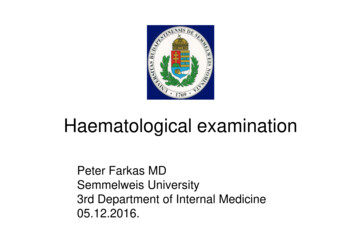
Transcription
Haematological examinationPeter Farkas MDSemmelweis University3rd Department of Internal Medicine05.12.2016.
Haematological examination Physical examination – inspection Lymphadenopathy Splenomegaly Special haematological examinations
Physical examination – Inspection Skin and its appendices– Paleness: anaemia– Plethoric aspect: polyglobulia– Jaundice: haemolytic anaemia, pernicousanaemia– Thrombocytopenic purpura (petechia,ecchymosis, suffusion): thrombocytopenia– Skin infections: neutropenia (lack of pus!)– Iron deficiency: dry skin, koilonychia, brittlehair and nail, hair loss, itching
Anaemia
Iron deficiency
Iron deficiency
B12 deficiency
Thrombocytopenia
Physical examination – Inspection Oral cavity, mucous membranes– Plummer-Vinson sy.: mucous membrane atrophy iniron deficient anaemia– Hunter’s glossitis: vitamin B12 deficiency– Petechia: thrombocytopenia– Gingiva hypertrophy: leukaemia– Aphthosus stomatitis, angina: agranulocytosis,leukaemia– Confluent tonsillitis: mononucleosis sy.
Lymphadenopathy Palpable – non-palpable Regional – generalized Size (soliter, conglomerate), speed of developmentTenderness, painSoft, thicken, hardRelation to the surrounding tissues (fixed pr mobile)Fluctuation, abscess/fistula formation„Mass effect” (VCS sy., tracheal/bronchial obstruction,bowel obstruction, DVT)
Lympadenopathy
Palpable lymphadenopathyMost common causes of lymphadenopathia based on its locationCervical- Bacterial infection- Mononucleosis sy.- Rubella- Tuberculosis- Lymphoma (frequently unilateral)- Head-neck tumors (frequently unilateral)Supraclavicular- Lung, retroperitoneal or gastrointestinal tumors- Lymphoma- Chest or retroperitoneal bacterial or fungal infectionAxillary- Bacterial infection, trauma of upper extremity- Cat scratch disease- Lymphoma- Breast cancer- Brucellosis- MelanomaInguinal- Bacterial infections of lower extremity, genitals or parianal region- Lymphoma- Pelvic tumors- Venereal diseases (lymphogranuloma venereum, syphilis I.)
Non-palpable and generalizedlymphadenopathyHilar- Sarcoidosis- Tuberculosis- Lung cancerMediastinal- Mononucleosis sy.- Sarcoidosis- Tuberculosis- Histoplasmosis- Lung cancer- LymphomaAbdominal/retroperitoneal- Tuberculosis- Lymphoma- Germinal tumors/seminoma- Other tumorsGeneralized lymphadenopathy- Infection (EBV, CMV, toxoplasmosis, tuberculosis, hepatitis, syphilis, HIV/AIDS, histoplasmosis)- Haematological malignancies: lymphomas, CLL, myeloid disorders: acut and chronic myelomonocytic leukaemia- Drug reactions- Other
LymphadenopathyCauses of lymphadenopathyI. Infectious- Viruses: mononucleosis sy.(EBV, CMV, HIV), hepatitis infectiosa, herpes simplex, rubella- Bacterias: Streptococcus, Staphylococcus, Brucella, Francisella tularensis, Treponema pallidum, Chlamydia,mycobacterias- Fungi: histoplasmosis, coccidiomycosis- Parazites: toxoplasmosis, leishmaniasis, trypanosomiasisII. Malignant disorders- Primary hematoligical disorders: lymphomas; myeloid disorders (acute and chronic myelomonocytic leukaemia)- Solid tumor metastasesIII. Disorders with immunpatomechanism- Autoimmun disorders: SLE, RA, MCTD, Sjögren-sy., vasculitis- SarcoidosisIV. Storage diseases Gaucher, Niemann–Pick-, Fabry-, Tangier-diseaseV. Endocrin disorders (lymphoid hyperplasia)HyperthyreosisVI. Other rare disorders- Castleman disease- Kikuchi disease- Histiocytosis- Dermatopathic lymphadenitis- Mucocutan lymphnode sy.(Kawasaki disease)
Splenomegaly Palpation, percussion, auscultation Size, tenderness, pain Soft, thicken, hard „Hypersplenism” – pancytopenia due tosequestration
Splenomegaly Portal hypertension– Liver cirrhosis– Hepatic, portal or splenic vein thrombosis Storage disorders– Gaucher, Niemann-Pick Systemic diseases– Sarcoidosis, amyloidosis, RA Infections– Acute Sepsis, IE, typhus abdominalis, Mononucleosis sy.– Chronic Tuberculosis, brucellosis, syphilis, malaria, leishmaniasis,schistosomiasis
Splenomegaly Haematological disorders– Haemolysis (RES hyperplasia): thalassaemiamajor and intermedia, sickle cell anaemia,any type of haemolytic anaemia– Malignancies Lymphoid: CLL, HCL, Lymphoma, ALL Myeloid: CML, MF, PRV, AML (Metastases of solid tumors)
Clinical presentation of CML
Useful laboratory testsGeneral CBC, reticulocyte Peripheral blood smear MGG: cytomorhology ESR, CRP EPOIron deficiency SeFe, Tf, Sat, SolTfR, FerritinMegaloblastic anaemia B12, folsavHaemolysis SeBi, LDH Direct Coombs, irregular antibodies Haptoglobin, plasma free haemoglobin HgbELFO RBC enzyme activityBlood loss Stool benzidin test, urine sedimentPlasma cell dyscrasia Total protein, ELFO, immunelfo, quantitative Ig
Useful haematopathological exams Bone marrow aspiration, biopsy & Lymphnodebiopsy– Cytomorhology, histology– Immune phenotype Flow cytometry (FACS) Immune histochemistry– Cytogenetics (metaphase analysis, FISH)– Molecular geneticsTypes of sampling:- surgical biopsy- core biopsy- FNAB of lympnodes is not recommended!Sometimes other organs (skin, stomach, bowel, spleen) for theseexaminations
Maturation of B-lymphocytesIgCell surface markersCD19CD10CD20CD38Precursor B-cellleukemiasCLL, B-celllymphomasWaldenström,myeloma
Maturation in the ymphocytesmalllargelargecleaved non-cleaved non-cleavedHsmalllymphocyteGplasmacell
Structure of a lymphnodeMantle zone:Mantle-cell NHLCLL/SLLWaldenströmmacroglobulinaemiaFollicular lymphomaBurkitt lymphomaSézary syndromeMycosis fungoidesPeripheral T-celllymphoma
A CML cytogenetikai markere: a Philadelphiakromoszóma (Ph)A Philadelphia kromoszóma (Ph)A Ph kromoszóma, ami nem más, mint egyrövidebb 22-es kromoszóma, a 9-es és 22es kromoszómák hosszú karjai közöttlétrejött reciprok transzlokációt(9:22)(q34;q11) eredménye 1Leukaemiás csontvelői metafázis sejtreprezentatív G-sávozású karyotípusa, amit(9;22)(q34;q11)-őt mutat.2A nyilak jelölik a 22-es kromoszómamegrövidült (Ph, 22q- vagy der(22)), illetve a9-es kromoszóma meghosszabbodott (9q vagy der(9)) származékát.2A KÉP CSAK ILLUSZTRÁCIÓKÉNT SZOLGÁL1. Druker BJ. Translation of the Philadelphia chromosome into therapy for CML. Blood. 2008;112(13):4808-17;2. Morris CM. Chronic mieloid leukemia: cytogenetic methods and applications for diagnosis and treatment. In: Campbell LJ,ed. Cancer Cytogenetics: Methods and Protocols, Methods in Molecular Biology, vol. 730. Springer Science Business,LLC;2011:33-61.
CML - FISHDr.Farkas Péter
CML molecular genetics:Bcr/abl translocationsBödör Csaba, SE.I.Pathológiai IntézetDr.Farkas Péter
Burkitt lymphoma BM smears
Burkitt lymphoma3., Cytogenetics - FISH C-MYC BAR and IgH/C-MYC probes shows in80% of nuclei c-myc breaks and t(8;14)translocation
Imaging techniques Xray (bone laesions of MM)USCTMRIGallium scanPET/CT
Multiple myeloma Skeletal X-ray PET scan:
Very agressive lymphoma Rapid deterioration within 2 weeks, fever, weightloss, abdominal pain. Palpable abdominal mass. CT scan:ClickforN
Very agressive lymphoma
SeBi, LDH Direct Coombs, irregular antibodies Haptoglobin, plasma free haemoglobin HgbELFO RBC enzyme activity Blood loss Stool benzidin test, urine sediment Plasma cell dyscrasia Total protein, ELFO, immunelfo, quantitative Ig